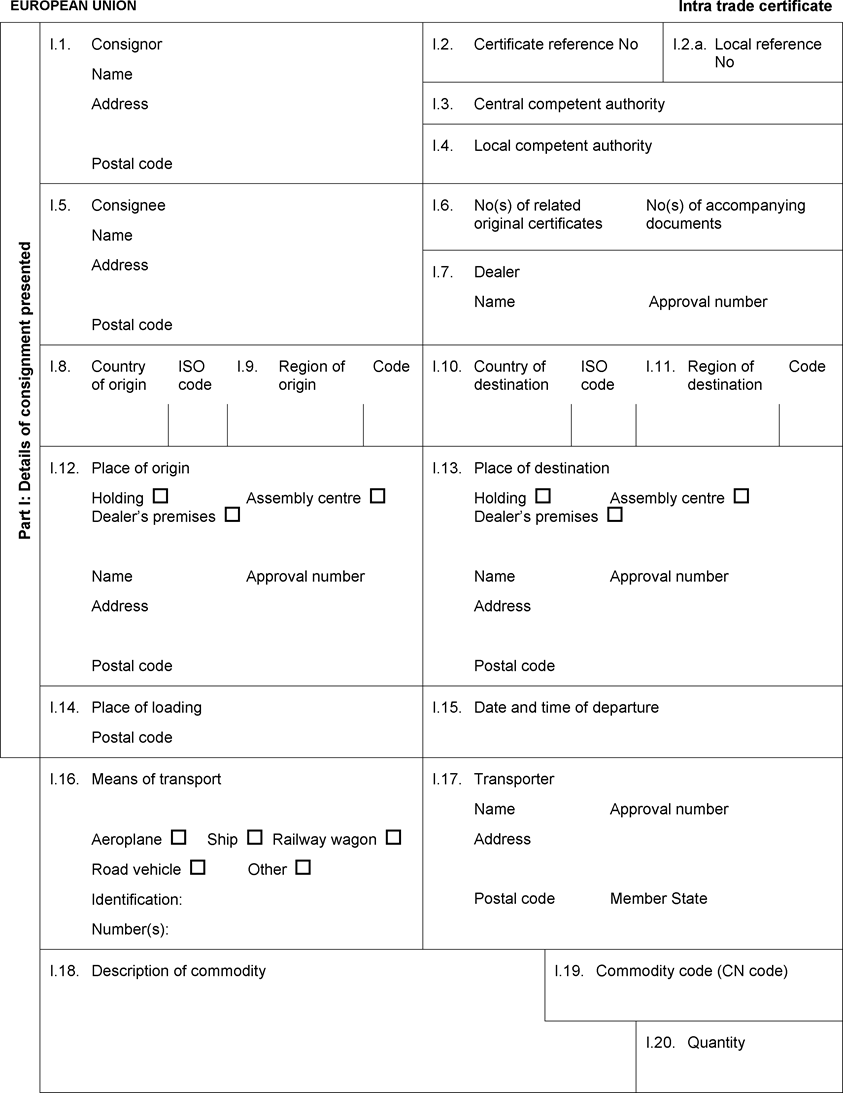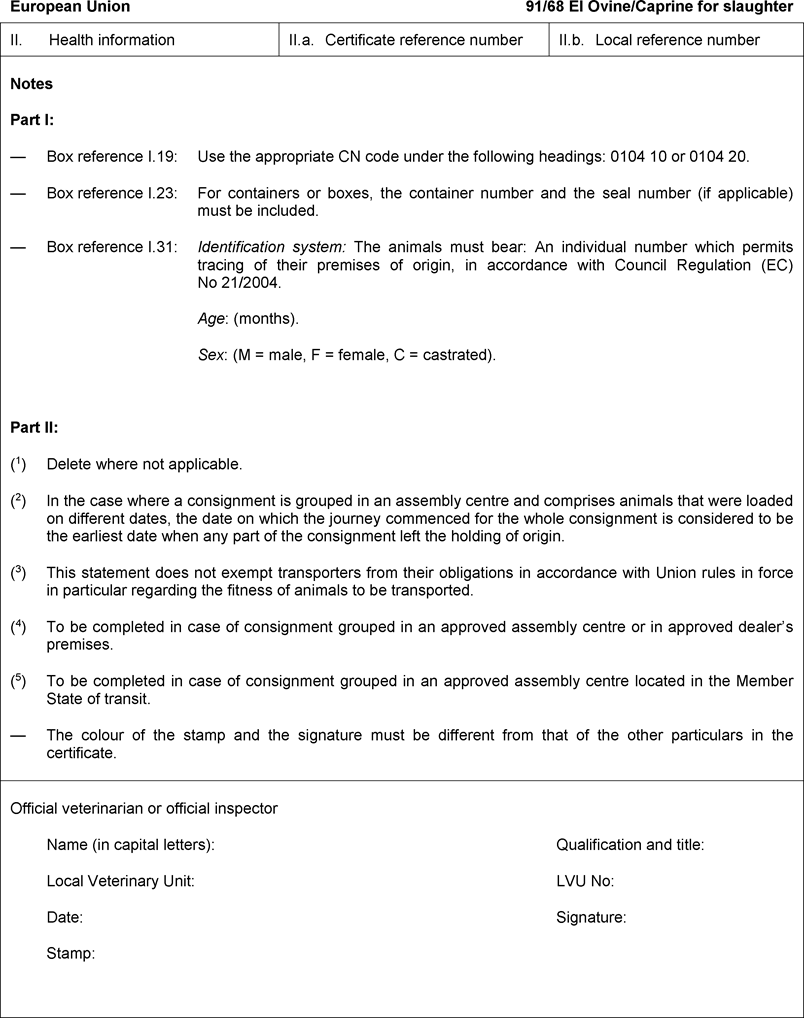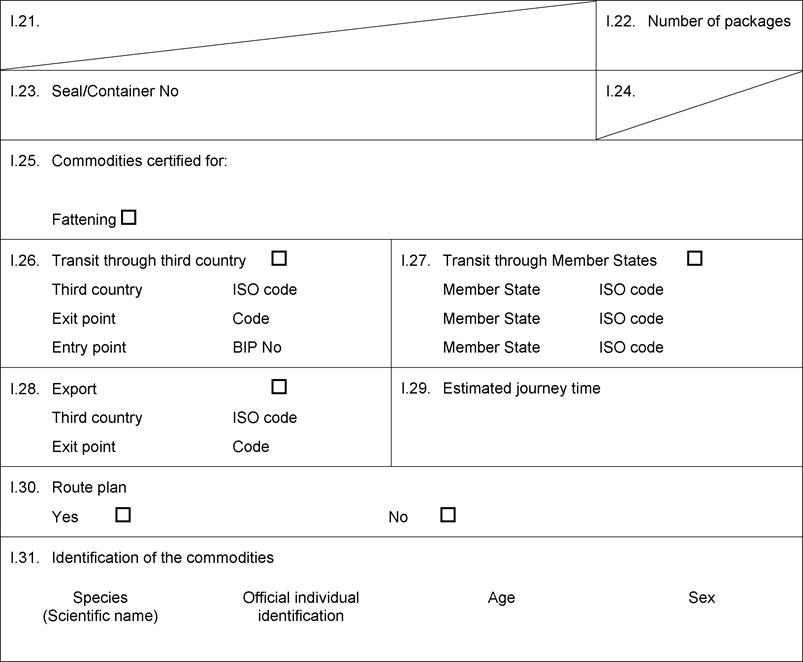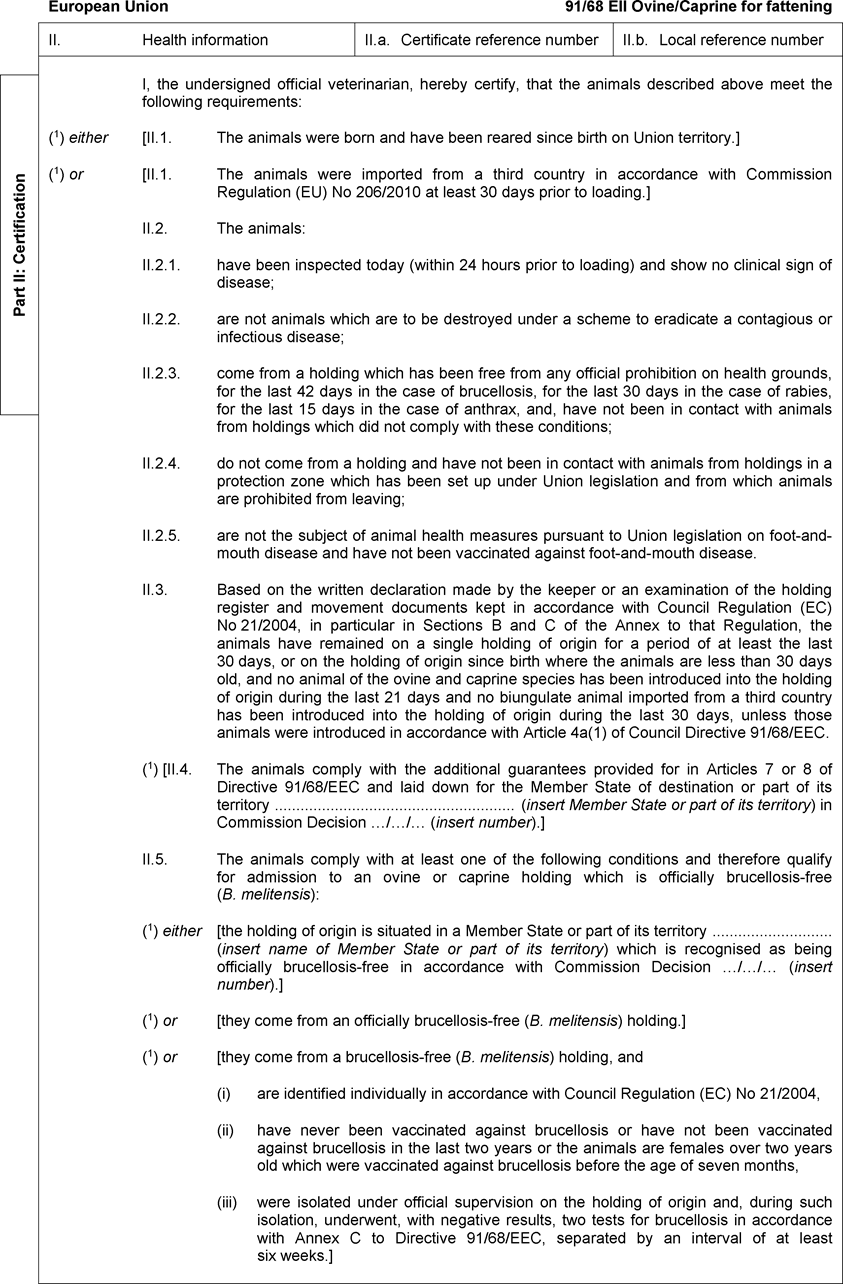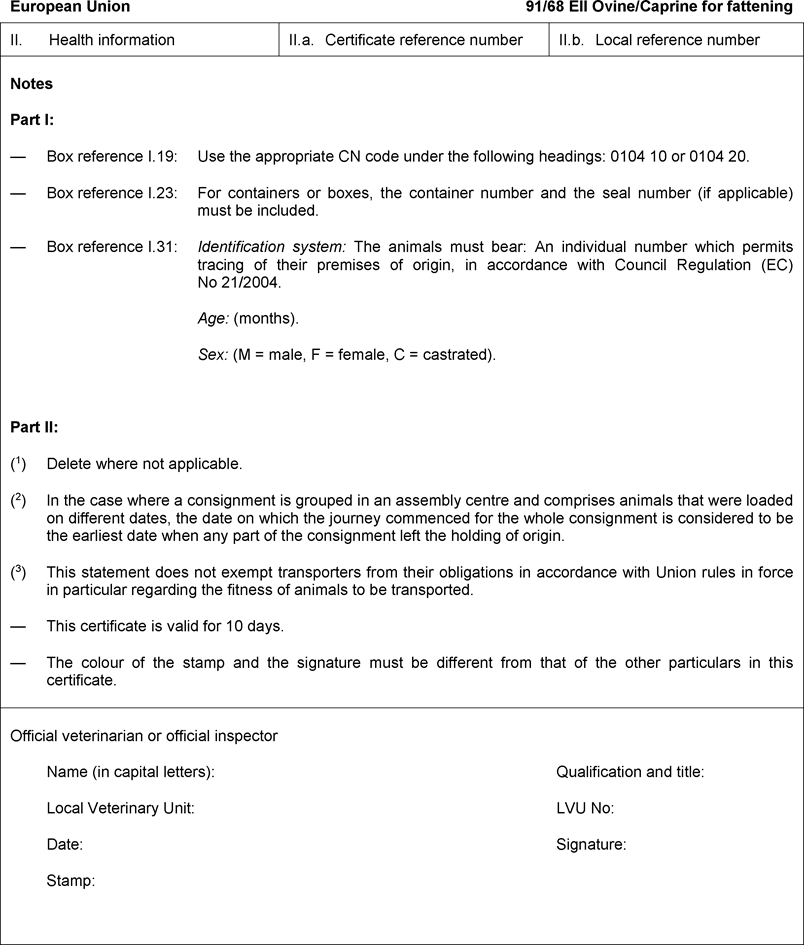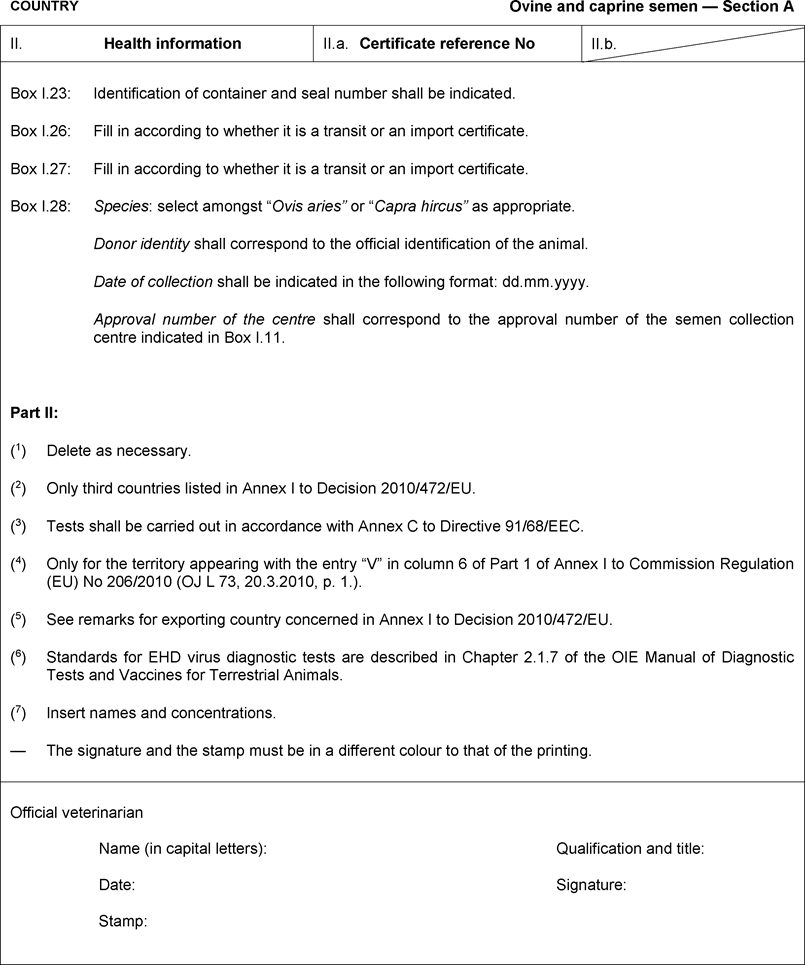Commission Implementing Decision (EU) 2016/2002
of 8 November 2016
amending Annex E to Council Directive 91/68/EEC, Annex III to Commission Decision 2010/470/EU and Annex II to Commission Decision 2010/472/EU concerning trade in and imports into the Union of ovine and caprine animals and semen of animals of the ovine and caprine species in relation to the rules for the prevention, control and eradication of certain transmissible spongiform encephalopathies
(notified under document C(2016) 7026)
(Text with EEA relevance)
THE EUROPEAN COMMISSION,
Having regard to the Treaty on the Functioning of the European Union,
Having regard to Council Directive 91/68/EEC of 28 January 1991 on animal health conditions governing intra-Community trade in ovine and caprine animals(1), and in particular Article 14(2) thereof,
Having regard to Council Directive 92/65/EEC of 13 July 1992 laying down animal health requirements governing trade in and imports into the Community of animals, semen, ova and embryos not subject to animal health requirements laid down in specific Community rules referred to in Annex A(I) to Directive 90/425/EEC(2), and in particular the fourth indent of Article 11(2), Article 17(2)(b), the first indent of Article 18(1) and the introductory phrase and point (b) of Article 19 thereof,
Whereas:
(1) Directive 91/68/EEC lays down the animal health conditions governing intra-Union trade in ovine and caprine animals. It provides, inter alia, that ovine and caprine animals must be accompanied during transportation to their destination by a health certificate conforming to Model I, II or III set out in Annex E thereto.
(2) Regulation (EC) No 999/2001 of the European Parliament and of the Council(3) lays down rules for the prevention, control and eradication of transmissible spongiform encephalopathies (TSEs) in bovine, ovine and caprine animals. Annex VII to that Regulation sets out the measures for the control and eradication of TSEs. In addition, Chapter A of Annex VIII to that Regulation lays down, inter alia, the conditions for intra-Union trade in live animals.
(3) Regulation (EC) No 999/2001 was recently amended by Commission Regulation (EU) 2016/1396(4). Those amendments provide, inter alia, for an exemption from the conditions set out in point 4.1 of Section A of Chapter A of Annex VIII to Regulation (EC) No 999/2001, which are aimed at preventing the spread of classical scrapie in farmed animals kept on holdings, for ovine and caprine animals moved exclusively between approved bodies, institutes or centres as defined in Article 2(1)(c) of Directive 92/65/EEC.
(4) Regulation (EU) 2016/1396 also introduces specific conditions for intra-Union trade in ovine and caprine animals of rare breeds which do not comply with the requirements of point 4.1 of Section A of Chapter A of Annex VIII to Regulation (EC) No 999/2001. Those specific conditions were introduced to maintain a possibility for regular exchange of such animals between Member States in order to avoid inbreeding and to preserve the genetic diversity in rare breed populations.
(5) The health certificates conforming to Models II and III set out in Annex E to Directive 91/68/EEC should therefore be amended in order to reflect the requirements relating to intra-Union trade in ovine and caprine animals of rare breeds or of those moved between approved bodies, institutes or centres laid down in Regulation (EC) No 999/2001, as amended by Regulation (EU) 2016/1396.
(6) In addition, some Member States notified the Commission of problems related to additional administrative work caused by the obligation to provide in point I.31 of health certificates conforming to Models I, II and III set out in Annex E to Directive 91/68/EEC details such as breed and quantity of animals forming the consignment. To reduce administrative burden for the official veterinarians, it is appropriate to remove from point I.31 of those model health certificates information on the breed, as such information is not necessary in relation to the health status of the animals in the consignment, and on the quantity of those animals, as such information is already stated in point I.20 and an official identification number of each individual animal must be provided in point I.31.
(7) Furthermore, in order to state more precisely the conditions for individual identification of the animals in points II.5 and II.6 of the health certificates conforming to Models II and III in Annex E to Directive 91/68/EEC, it is necessary to introduce in those points a reference to Council Regulation (EC) No 21/2004(5).
(8) Directive 91/68/EEC should therefore be amended accordingly.
(9) Directive 92/65/EEC lays down conditions applicable to trade in and imports into the Union, inter alia, of semen of animals of the ovine and caprine species.
(10) Annex III to Commission Decision 2010/470/EU(6) lays down model health certificates for trade within the Union in consignments of semen of animals of the ovine and caprine species. Part A of that Annex sets out the model health certificate for semen collected after 31 August 2010 and dispatched from an approved semen collection centre of origin of the semen.
(11) Annex II to Commission Decision 2010/472/EU(7) lays down, inter alia, model health certificates for the imports into the Union of consignments of semen of animals of the ovine and caprine species. Section A of Part 2 of that Annex sets out the model health certificate for semen dispatched from an approved semen collection centre of origin of the semen.
(12) Point 4.2 of Section A of Chapter A of Annex VIII to Regulation (EC) No 999/2001 sets out the scrapie-related conditions to be fulfilled for intra-Union trade in semen of ovine and caprine animals. Chapter H of Annex IX to Regulation (EC) No 999/2001 sets out the scrapie-related conditions to be fulfilled for imports of semen of ovine and caprine animals.
(13) Regulation (EU) 2016/1396 introduces specific conditions for semen collection centres amongst the conditions for a holding to be recognised as having a negligible risk or a controlled risk of classical scrapie in points 1.2 and 1.3 of Section A of Chapter A of Annex VIII to Regulation (EC) No 999/2001, given that the risk of spreading scrapie via male ovine and caprine animals kept at semen collection centres approved and supervised in accordance with the conditions set out in Annex D to Directive 92/65/EEC is limited. A reference to those specific conditions is also introduced in the conditions for trade in and import of semen of ovine and caprine animals set out in Annexes VIII and IX to Regulation (EC) No 999/2001 respectively.
(14) The model health certificate for intra-Union trade in consignments of semen of animals of the ovine and caprine species set out in Part A of Annex III to Decision 2010/470/EU and the model health certificate for imports into the Union of consignments of semen of animals of the ovine and caprine species set out in Section A of Part 2 of Annex II to Decision 2010/472/EU should therefore be amended in order to reflect the requirements relating to semen collection centres laid down in Regulation (EC) No 999/2001, as amended by Regulation (EU) 2016/1396.
(15) In addition, Chapter H of Annex IX to Regulation (EC) No 999/2001, as amended by Regulation (EU) 2016/1396, provides that meat-and-bone meal should be understood as defined in the Terrestrial Animal Health Code of the World Organisation for Animal Health (OIE)(8), rather than in point 27 of Annex I to Commission Regulation (EC) No 142/2011(9).
(16) Therefore, point II.4.10.4 of the model health certificate for imports into the Union of consignments of semen of animals of the ovine and caprine species set out in Section A of Part 2 of Annex II to Decision 2010/472/EU should be amended according to the amended provisions of Chapter H of Annex IX to Regulation (EC) No 999/2001.
(17) Decisions 2010/470/EU and 2010/472/EU should therefore be amended accordingly.
(18) Regulation (EU) 2016/1396 provides that the amendments made to Annex IX to Regulation (EC) No 999/2001 and related to imports of certain commodities are to apply from 1 July 2017. In addition, to avoid any disruption of imports into the Union of consignments of semen of ovine and caprine animals, the use of certificates issued in accordance with Decision 2010/472/EU as applicable prior to the amendments being introduced by this Decision should be authorised during a transitional period subject to certain conditions.
(19) The measures provided for in this Decision are in accordance with the opinion of the Standing Committee on Plants, Animals, Food and Feed,
HAS ADOPTED THIS DECISION:
Article 1U.K.
Annex E to Directive 91/68/EEC is amended in accordance with Annex I to this Decision.
Article 2U.K.
Annex III to Decision 2010/470/EU is amended in accordance with Annex II to this Decision.
Article 3U.K.
Annex II to Decision 2010/472/EU is amended in accordance with Annex III to this Decision.
Article 4U.K.
Article 3 of this Decision shall apply from 1 July 2017.
For a transitional period until 31 December 2017, consignments of semen of ovine and caprine animals, accompanied by a health certificate issued in accordance with the model set out in Section A of Part 2 of Annex II to Decision 2010/472/EU, as applicable before the amendments made by this Decision, shall be authorised for importation into the Union provided that the certificate was issued no later than 30 November 2017.
Article 5U.K.
This Decision is addressed to the Member States.
Done at Brussels, 8 November 2016.
For the Commission
Vytenis Andriukaitis
Member of the Commission
ANNEX IU.K.
Annex E to Directive 91/68/EEC is replaced by the following:
“ANNEX E
MODEL IU.K.
MODEL IIU.K.
MODEL IIIU.K.
”
ANNEX IIU.K.
In Annex III to Decision 2010/470/EU, Part A is replaced by the following:
‘Part A U.K.
Model health certificate IIIA for trade within the Union in consignments of semen of animals of the ovine and caprine species collected in accordance with Council Directive 92/65/EEC after 31 August 2010 and dispatched from an approved semen collection centre of origin of the semen
’
ANNEX IIIU.K.
In Part 2 of Annex II to Decision 2010/472/EU, Section A is replaced by the following:
‘Section A U.K.
Model 1 — Health certificate for semen dispatched from an approved semen collection centre of origin of the semen
’
Regulation (EC) No 999/2001 of the European Parliament and of the Council of 22 May 2001 laying down rules for the prevention, control and eradication of certain transmissible spongiform encephalopathies (OJ L 147, 31.5.2001, p. 1).
Commission Regulation (EU) 2016/1396 of 18 August 2016 amending certain Annexes to Regulation (EC) No 999/2001 of the European Parliament and of the Council laying down rules for the prevention, control and eradication of certain transmissible spongiform encephalopathies (OJ L 225, 19.8.2016, p. 76).
Council Regulation (EC) No 21/2004 of 17 December 2003 establishing a system for the identification and registration of ovine and caprine animals and amending Regulation (EC) No 1782/2003 and Directives 92/102/EEC and 64/432/EEC (OJ L 5, 9.1.2004, p. 8).
Commission Decision 2010/470/EU of 26 August 2010 laying down model health certificates for trade within the Union in semen, ova and embryos of animals of the equine, ovine and caprine species and in ova and embryos of animals of the porcine species (OJ L 228, 31.8.2010, p. 15).
Commission Decision 2010/472/EU of 26 August 2010 on imports of semen, ova and embryos of animals of the ovine and caprine species into the Union (OJ L 228, 31.8.2010, p. 74).
http://www.oie.int/index.php?id=169&L=0&htmfile=glossaire.htm
Commission Regulation (EU) No 142/2011 of 25 February 2011 implementing Regulation (EC) No 1069/2009 of the European Parliament and of the Council laying down health rules as regards animal by-products and derived products not intended for human consumption and implementing Council Directive 97/78/EC as regards certain samples and items exempt from veterinary checks at the border under that Directive (OJ L 54, 26.2.2011, p. 1).
